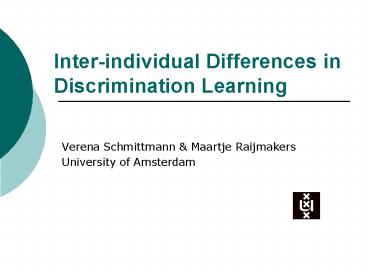Interindividual Differences in Discrimination Learning - PowerPoint PPT Presentation
1 / 21
Title:
Interindividual Differences in Discrimination Learning
Description:
Focus shifts from positive to negative feedback; possibly different strategies ... modes of learning (e.g., Kendler, 1979; Raijmakers, Dolan and Molenaar, 2001) ... – PowerPoint PPT presentation
Number of Views:58
Avg rating:3.0/5.0
Title: Interindividual Differences in Discrimination Learning
1
Inter-individual Differences in Discrimination
Learning
- Verena Schmittmann Maartje Raijmakers
- University of Amsterdam
2
Different strategies in Rule/Feedback Learning
- Focus shifts from positive to negative feedback
possibly different strategies (e.g., van
Duijvenvoorde, et al 2008) - Rule learning in adults (e.g., Sirois et al,
2006 Mutter et al, 2006) - Discrimination learning task Evidence for
different modes of learning (e.g., Kendler, 1979
Raijmakers, Dolan and Molenaar, 2001)
3
Simple discrimination learning task
- Stimuli differ on two binary valued dimensions
- Form (Circle/Triangle)
- Size (Small/Large)
- Feedback provides information on correct
feature Circle, Triangle, Small, or Large
4
Underlying learning processes - sequence of
responses of one child (red)
correct
error
correct
underlying sudden learning process
error
correct
underlying gradual learning process
error
5
Data
- two studies ( N230, 4-20 years and N300,
4-14 years) - from each participant, sequence of accuracies on
all trials was recorded, e.g.,011000110101111111
11 0110111111111
6
Fast Hypothesis Testing
- Fast learning, well described by model of
hypothesis testing
1
lp learning parameterblue transition
probabilitiesred probability of correct response
lp
Adapted from original CI model, Bouwer
Trabasso, 1964
7
Development
Estimated Proportion of Fast Hypothesis
Testers (bars 95CI)
Age Group
8
Slow Learning
- One-trial learning from chance level to near
perfect performance - Less efficient than choosing hypothesis at random
from pool of features upon every error - Likely inefficient hypothesis testing
Trial of Learning
ErrorProb.
Blocks of Four Trials
9
Why trial-by-trial modeling?
- theory-based
- averaging may distort results, change inferences
Probability correct
10
Discrimination shift learning
- after learning criterion, reversal shift of
reinforcement contingencies - different learning strategies in shift phase?
- same strategy in both phases of task? expected
rational learning in initial phase -gt rational
learning in shift phase
11
Discrimination Shift Model
12
Results Shift Learning
- Two modes of reversal shift learning
- Fast initial learning may be paired with slow
shift learning (neg. transfer especially in the
youngest age group), and with fast shift learning - Slow initial learning may be paired with fast
shift learning (pos transfer especially in the
older age groups) - Response accuracy in applying the reversed rule
increased with age, and is below criterion
accuracy in the youngest age groups
13
Number of trials to fixed learning
criterionInitial learning (x) by shift learning
(y)in 4 age groups
traditional measure overestimates trial of
learning in young children
14
Questions
- Do some 4-5 year olds employ a fast hypothesis
testing strategy, or do they have a preference
for the correct feature? - Relation of learning strategy to - dimension
preference? - attentional control? - working
memory?
15
Study II
- N302 4 to 14 years, 5 age groups
- Discrimination learning task, relevant dimension
non-preferred dimension - Attentional control/ Inhibition Eriksen flanker
task (e.g., Ridderinkhof et al, 1995) - Working memory spatial working memory task (v.
Leijenhorst et al. 2007) - Conditional reasoning task
16
Mixture model
Initial ProbabilitiesL .053E .5C
.447
Initial ProbabilitiesL 0P 1
Initial ProbabilityG 1
Markovian Learning models fitted to
trial-by-trial accuracy data by ML estimation
using the R-package depmix (Ingmar Visser)
17
DevelopmentProportions of learning strategies
by age group
F Fast Hypothesis Testing S Slow Learning N
Non-learning
Estimated Proportion of Strategy (bars SE)
Age Group
18
Preference Learning Strategy 4-5 year-olds
Estimated Proportions of Strategies
Strategy
proportion did not differ sig.from 0 gt fixed
19
Hierarchical Regression AnalysisAge, Attentional
Control Working Memory
- Age significant predictor of all learning
strategies - Working Memory and Attentional Control measures
significant predictors of fast hypothesis testing
and of non-learning
20
Conclusions
- statistical modeling support for existence of
mixture of learning processes - no evidence for incremental discrimination
learning in young children - Evidence for fast hypothesis testing in 4-5
year-olds without strong preference - preference for irrelevant dimension hurt learning
in youngest children (4-5 yrs) - working memory and attentional control predicted
learning strategy - trial-by-trial modeling of learning processes can
reveal relevant information
21
Acknowledgments
- Maartje Raijmakers
- Han van der Maas
- Ingmar Visser
- Raoul Grasman
- Linda van Leijenhorst
- Mariette Huizinga
- undergraduate students
- participants































